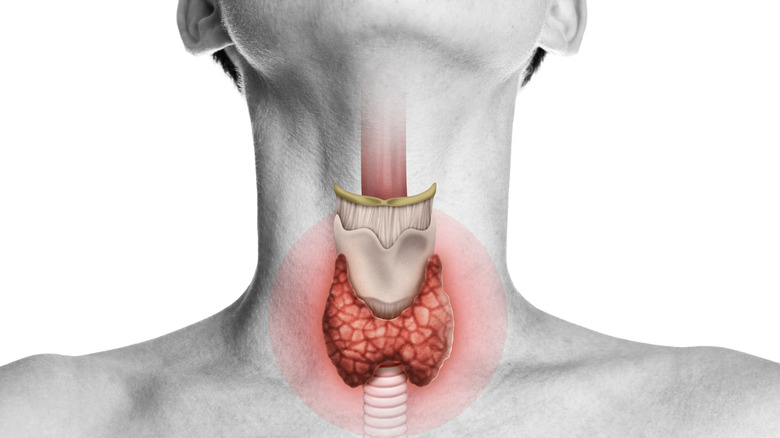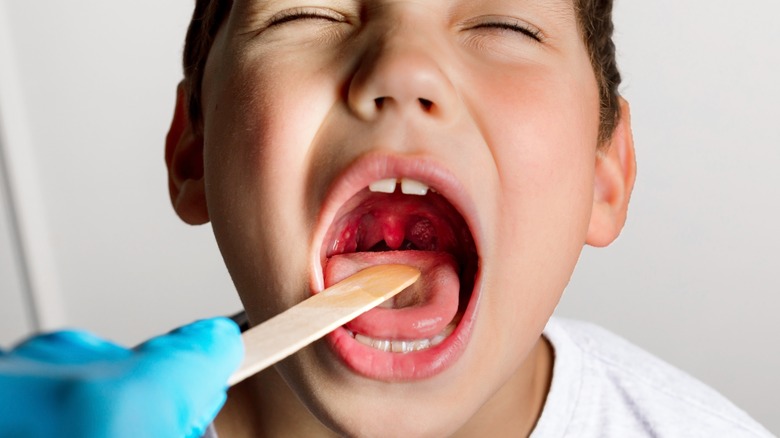What Is Cobblestone Throat?
Cobblestone throat refers to an inflamed or infected throat characterized by the presence of small (and sometimes red) bumps on the back of the throat resembling cobblestones (via Cleveland Clinic). According to Healthgrades, the bumps emerge due to various changes in the throat, including enlarged tonsils and the collection of lymphoid tissues. According to Cleveland Clinic, cobblestone throat has various underlying causes. So it's difficult to accurately estimate how many people suffer from the condition since it isn't a specific disease.
Additionally, cobblestone throat is a term that describes a specific appearance of the throat. It's more colloquial and may not necessarily be used by all healthcare providers. However, the condition is often associated with a sore throat (also known as pharyngitis), according to Medical News Today. It's estimated that sore throat accounts for around 2% of medical visits yearly — many of these cases are caused by infection, says Healthline.
Causes of cobblestone throat
Several things can cause the throat to become inflamed or infected, resulting in a cobblestone appearance. The most common culprits include viral infections, allergies, and acid reflux, explains Cleveland Clinic. Viral infections are usually associated with the flu, says the clinic. Bacterial infections, such as strep throat, can also cause cobblestone throat. According to Medical News Today, these infections are more common in children. Furthermore, they can be severe and may require treatment with antibiotics, says Healthline. As for allergies, they can also cause throat inflammation and are usually triggered by dust, pollen, and mold (via the Cleveland Clinic).
Acid reflux, also known as gastroesophageal reflux disease (GERD), is another condition that causes the throat to inflame with a cobblestone appearance. This occurs when stomach acid flows back into the throat, causing irritation and inflammation, says Healthgrades. Beyond the conditions mentioned above, other environmental factors like breathing in toxic chemicals from cigarette smoke or dry air are other contributing factors, says Cleveland Clinic.
Common signs and symptoms of cobblestone throat
In addition to the bumps on the surface of the throat, cobblestone may also be accompanied by other symptoms depending on the underlying cause, says the Cleveland Clinic. For example, viral infections caused by flu generally cause fever, fatigue, and body aches, per the University of California Los Angeles (UCLA). If caused by an infection, the condition may induce fatigue due to the body's response to the infection or inflammation, says UCLA. In contrast, bacterial infections may cause fever and swollen lymph nodes (via Mayo Clinic), while sore throats may be accompanied by pain or discomfort when swallowing, explains Healthgrades.
Cobblestone throat caused by allergies may be accompanied by sneezing, itchy eyes, and a runny nose — since these are the most common symptoms of allergies, per the National Health Services (NHS). As for acid reflux, accompanying symptoms may include heartburn and a sour taste in the mouth (via WebMD). Lastly, swollen lymph nodes, particularly in the neck, may be present with cobblestone throat due to an infection or inflammation. It's important to see a doctor if you are experiencing symptoms of cobblestone throat, as the underlying cause will need to be identified and treated.
How is cobblestone throat diagnosed?
According to Cleveland Clinic, cobblestone throat is typically diagnosed through a physical examination. Your doctor may also ask about the symptoms you're experiencing and any other medical conditions that may be present. In some cases, additional testing may be necessary to confirm the diagnosis and identify the underlying cause of the cobblestone throat.
A throat culture test might be needed to test for germs, explains the clinic. The process typically involves taking a sample of the throat secretions and testing it in a laboratory to identify the presence of bacteria or other organisms, says Neymour Kids Health. According to Medical News Today, a throat culture test might be needed to rule out chlamydia and Streptococcus bacteria (the primary bacteria that causes strep throat). Similar to a throat culture test, a rapid strep test is a quick and simple test that can also determine whether strep bacteria are present in the throat, per the Centers for Disease Control and Prevention (CDC).
Home remedies for cobblestone throat
According to Medical News Today, many infections responsible for causing cobblestone throat tend to go away on their own. However, several home remedies may help to alleviate the symptoms of cobblestone throat and provide some relief. Warm liquids, such as tea or soup, may be particularly helpful for eliminating mucus, says Cleveland Clinic.
The clinic also advises sucking on throat lozenges to maintain the throat's moisture. According to the clinic, a humidifier might also help to add moisture to the air, which can relieve dryness and soreness in the throat. If acid reflux is the cause of your cobblestone throat, Healthline advises limiting alcohol consumption and avoiding irritants like tobacco smoke. This might help to reduce irritation and inflammation in the throat, explains Healthline.
It's important to note that these remedies aren't intended to replace medical treatment, and it's crucial to see a doctor if your symptoms worsen even after at-home treatments.
Treatment with medications
The treatment for cobblestone throat will depend on the underlying cause of the condition. If the cause of cobblestone throat is a bacterial infection, treatment with antibiotics might be needed to help to kill the bacteria and prevent further infection, explains Cleveland Clinic. If the pain is too much, over-the-counter pain medications can help to reduce pain and soreness associated with cobblestone throat, according to Healthline.
If cobblestone throat is caused by allergies, over-the-counter nasal decongestants like pseudoephedrine may help reduce inflammation and congestion. Antihistamines like loratadine might also help, says the source. Your doctor might also advise avoiding allergens that trigger an immune response.
It's important to communicate your symptoms clearly with your doctor. Although cobblestone throat isn't a sign of cancer, if your symptoms are accompanied by a neck lump, problems swallowing, and unexplained weight loss, it would be best to see a doctor, says Healthline.






